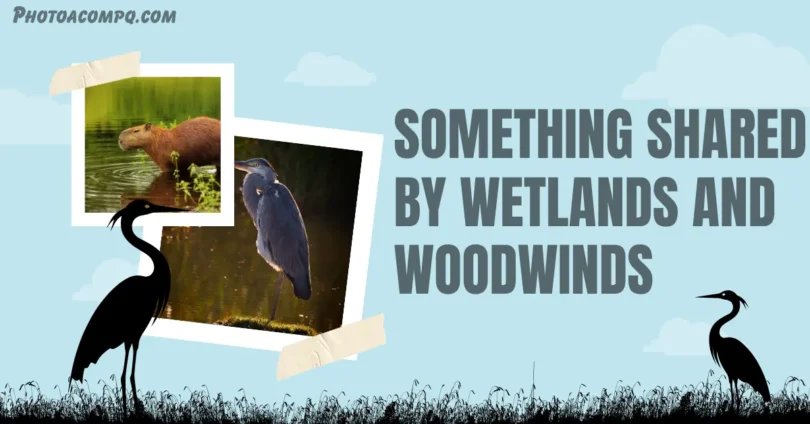Something Shared by Wetlands and Woodwinds may sound like a strange idea at first, because one belongs to nature and the other to music. Wetlands are living places filled with water, plants, and animals, while woodwinds are instruments that make soft and beautiful sounds. But if we look deeper, we can see that both have one important thing in common they depend on air and balance to create harmony. Just like wetlands keep our earth healthy, woodwinds bring life to music.
Wetlands Nature is Breathing System
Wetlands are often called the breathing system of nature because they work like the lungs of our planet. Just as lungs clean the air we breathe, wetlands clean water by filtering out dirt and harmful chemicals. They also give fresh oxygen to the environment through plants and support countless animals, birds, and fish.
Without wetlands, the earth would lose a natural way of keeping balance in water, air, and life. This is why scientists and nature lovers see wetlands as one of the most important systems that help our planet stay alive and healthy.
Woodwinds Musics Breathing System
Woodwind instruments are called the breathing system of music because they need air to create sound. Just like our breath gives life to our body, the breath of a musician gives life to woodwinds. When air moves through these instruments, it turns into notes that can be soft, gentle, or strong.
Flutes, clarinets, oboes, and saxophones are all part of the woodwind family. They add balance and beauty to an orchestra, just like wetlands add balance to nature. Without the breath of air, woodwinds would be silent, showing us how closely music depends on breathing and harmony.
Shared Element – The Power of Airflow
Air is the invisible force that connects both wetlands and woodwinds. Without airflow, neither could perform their special role.
- Wetlands clean the air by trapping dust, gases, and harmful particles.
- Wetlands release oxygen through plants, helping people and animals breathe.
- Woodwinds depend on breath to create sound and music.
- Airflow controls tone in woodwinds, just as it controls health in wetlands.
- Both show balance air must move smoothly for wetlands to stay alive and for woodwinds to play correctly.
Airflow is the shared heartbeat of both wetlands and woodwinds, proving how one simple element connects nature and music.
Shared Rhythm – The Role of Harmony and Balance
Harmony and balance are the secret rhythms that connect wetlands and woodwinds. Both need order and coordination to keep life flowing smoothly.
- Wetlands keep balance in nature by controlling floods, storing water, and supporting wildlife.
- Wetlands create rhythm in seasons, as water levels rise and fall in a natural cycle.
- Woodwinds bring harmony in music by blending their sounds with strings, brass, and percussion.
- Woodwinds follow rhythm where every note must match the timing to keep music beautiful.
- Both show teamwork wetlands work with earth, air, and water, while woodwinds work with other instruments.
The shared rhythm of wetlands and woodwinds teaches us that balance and harmony are needed in both nature and music to keep everything alive and beautiful.
Shared Voice – Giving Life and Expression
Both wetlands and woodwinds have a special voice that gives life and expression in their own worlds. One speaks through nature, and the other through music.
- Wetlands give life by providing homes for birds, fish, and plants.
- Wetlands express nature’s voice through the sounds of water, frogs, and flowing streams.
- Woodwinds give music a voice by turning simple air into emotional notes.
- Woodwinds express feelings from joy and peace to sadness and hope.
- Both inspire humans wetlands with their beauty, woodwinds with their melodies.
The shared voice of wetlands and woodwinds shows us that life and expression can flow from both nature and music, touching hearts in different but powerful ways.
Shared Fragility – Sensitivity to Change
Wetlands and woodwinds may seem strong, but both are very sensitive to changes around them. Their fragility reminds us to treat them with care.
- Wetlands are fragile because pollution, deforestation, and climate change can damage them quickly.
- Wetlands lose balance when water levels drop or rise too fast.
- Woodwinds are delicate instruments that can crack, warp, or lose sound quality if not cared for properly.
- Woodwinds react to air pressure even a small change in breath can change the tone.
- Both depend on balance in their surroundings to stay healthy and effective.
The shared fragility of wetlands and woodwinds teaches us that beauty and harmony can only survive when we protect and respect them.
Lessons from the Shared Connection
The link between wetlands and woodwinds teaches us valuable lessons about life, balance, and care. Nature and music both guide us in simple but powerful ways.
- Value the basics just as air is vital for both, we must respect simple things that keep life going.
- Protect what is fragile wetlands and woodwinds both show that beauty can be easily lost if not cared for.
- Balance is key nature needs balance to stay alive, and music needs balance to sound beautiful.
- Work together wetlands, animals, and plants work as a team, just like woodwinds join other instruments in harmony.
- Express and inspire both remind us to use our voice, whether through caring for nature or creating music.
The shared connection between wetlands and woodwinds teaches us to live with balance, care, and respect for the world around us.
Conclusion | Something Shared by Wetlands and Woodwinds
Wetlands and woodwinds may belong to very different worlds, but both show us the same truth: life depends on air, balance, and harmony. Wetlands breathe life into nature, while woodwinds breathe life into music. Both are fragile yet powerful, gentle yet essential. By caring for our environment like we care for music, we can create a world that is healthy, balanced, and full of expression. In the end, wetlands and woodwinds remind us that nature and music share one breath and that breath is what keeps life beautiful.



